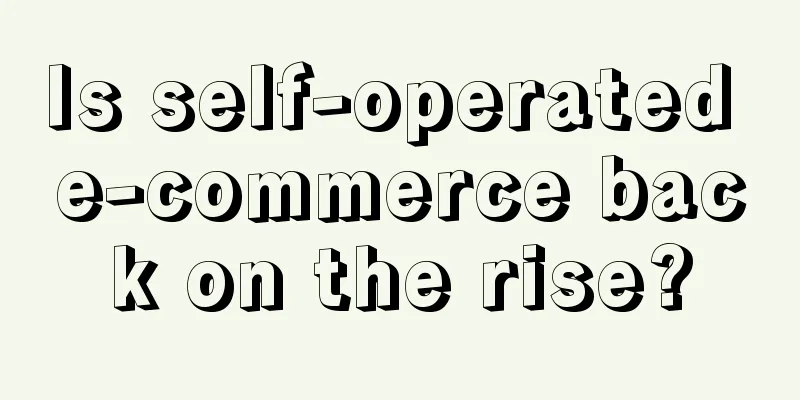Brand, the greatest concept in business history

01Brands have created a modern, mature and developed business system. In today's business society, brand purchasing behavior has become ubiquitous. At the same time, the formation of brand concepts and brand ideas is the most significant conceptual revolution in the history of business. The emergence of brand concepts and brand theories has separated brands from products. Since then, the business world has clearly recognized the difference between brands and products. This conceptual revolution directly gave birth to modern business and marketing. Brand originates from category/product, but it is higher than product. When brand breaks away from the restraint and limitation of product, brand idea also flourishes like mushrooms after rain. If we regard "Products and Brands" published by Gardner and Levy in "Harvard Business Review" in 1955 as the foundation of brand concept and brand theory, then in the more than 60 years since then, brand theory has been constantly evolving and surpassing itself. 02The first self-transcendence of the brand concept came from the rise of the brand from marketing promotion to the strategic level . The brand is no longer a tool for promotion, but a strategic competitiveness of the enterprise, and the most valuable intangible asset of the enterprise. Its landmark event was the publication of Aaker's "Brand Equity Trilogy" and Keller's "Strategic Brand Management" in the 1990s. 03The second self-transcendence of brand concept comes from the shift from focusing on the brand itself to focusing on the relationship between the brand and consumers. In the past, brands were defined based on the brand itself, but at this stage, brands are defined based on the relationship between the brand and consumers. 04The third self-transcendence of brand concept came from the past 10 years, with the rise of fragmented media, the rapid iteration and evolution of technology, the improvement of supply chain, and many brands’ blind emphasis on the relationship between brand and users. As a result, brands have to occupy a large amount of users’ and consumers’ time in order to “establish relationships” with customers. Text messages, phone calls, official accounts, private domains, memberships… these unscrupulous “relationship” means have brought great troubles to users. With the help of big data and artificial intelligence, this kind of relationship has become a means of "doing evil". It is not uncommon for big data to kill old customers. The concept of brand must be re-iterated and regressed: the essence of an enterprise is a business machine. Products, marketing, supply chain, management, etc. are all parts of this business machine, and the brand is the finished product of this business machine. The emphasis of the enterprise on the relationship with the user is still from the standpoint of how to continue to make customers spend money. What the brand needs to do more is to encapsulate everything into the brand and deliver it to the user. 05Brand building in the traditional era comes from the packaging of things. For example, a symbol, a trademark, a name is packaged on the product; a selling point, a positioning is packaged; an image is packaged, and the product is endowed with attitude, personality, and emotion, so that the product generates a premium and wins user recognition. Brand building in the digital age comes from the operation of people. The various concepts and marketing methods we often talk about today, such as scenarios, communities, interactions, fans, private traffic, and growth hackers, all start from how to connect with users and build relationships. Brands start from products, but are defined by users. User image determines brand image, and customer cognitive value determines brand value. Understanding the brand-consumer relationship can help us grasp the essence of the brand. The formation of brand encapsulation theory directly transcends single-point thinking to think about brands, and coordinates brand strategies from the perspective of the overall enterprise. 06McCarthy, an American commercial marketing practitioner, once proposed that complete marketing consists of four elements, namely Product, Price, Place, and Promotion. These four marketing elements are collectively referred to as the 4Ps of marketing. After the 4Ps of marketing were proposed, some people later added N Ps to the end, making it 6P, 8P, 12P, etc., but no matter how many Ps there are, the four core elements of marketing have never changed. Professor Schultz, who graduated from Northwestern University in the United States with Kotler and is world-renowned, mentioned in his important book "Integrated Marketing Communications": With the changes in the market environment, the core of marketing is also changing. In the new environment, 4Ps are outdated. The thinking of brand marketing should shift from the 4Ps of marketing to the 4Cs of marketing, namely demand, value, convenience, and communication. From a purely academic logic, the 4Cs of marketing make sense. That is, you should not only consider what products to make, but also consider what needs consumers have from their perspective; do not only consider what price to sell to consumers, but also consider what value to bring to consumers; do not only consider what channels to sell products and services to consumers, but also consider what methods can make consumers more convenient; do not always think about how to spread, promote and promote, but do everything possible to reason with consumers and communicate. However, if companies really follow Schultz's way of playing from organization to operation, no company will be able to play well. Using the term used by Nobel Prize winner in Economics Ronald Coase to refer to impractical economics as "blackboard economics", Schultz's 4C marketing can be called "blackboard marketing". In the more than 30 years since Schultz's Integrated Marketing Communications was published and became a popular book around the world, no company has achieved success in brand marketing by relying on this set of theoretical guidance. As time goes by, Schultz's integrated marketing communication theory has also been slowly forgotten. 07Since the 4Ps of marketing have withstood the test of time, their theoretical foundation and practicability have been proven by all enterprises in the past 60 years of business practice. Products have become an important strategy for corporate development. For a company like Apple, every success is supported by a successful product. The launch of the Apple Music Player allowed Steve Jobs to confidently announce to the world that he had made Apple successful again after his return; the launch of the iPhone allowed Apple to complete the iterative revolution from feature phones to smartphones; and the launch of the iPhone tablet allowed Apple to define the tablet computer. Products are about product structure. Each product has its own role and strategic mission. Products need to be launched in the right order. Price means the choice of marketing model , the definition of product value and the logic of interest distribution for each participant. Channels are the "political system" of the enterprise , which is the sum of the whole process of product flow from producers to consumers. The purpose of promotion is to make the products and services of the enterprise widely known. 08Since enterprises have completed a complete marketing campaign through the four steps of product, price, channel and promotion in the process of interacting with consumers, why do they need to separate another dimension of "brand" from marketing? Is brand redundant? This question does not need to be discussed in too much detail. The fact that companies of a certain size will mention brands in their daily meetings is enough to illustrate the importance of brands. If a company does not mention its brand, it will not be able to have in-depth and complete communication with its stakeholders. What does this mean? 09Let's restore the dialogue scene in the business field: When the company's sales staff sells products to consumers, they will say: "Try our products. Our products are delicious. We are a time-honored brand with many years of experience and are trustworthy." When consumers or channel dealers ask why your products are so expensive, the company's marketing staff will say: "We are branded products, and our products are different from those of non-branded companies." When marketing personnel are looking for distributors, they will say: "Our brand is worth your business, our brand is very powerful, and you can make a profit by doing business with our brand." If a company must hold a promotional event in a high-end office building, such as Shanghai Center, or if the company wants to move into a high-end office building, or if the company's products want to be sold in a high-end shopping mall, then the investment promotion personnel in these places will definitely be concerned about whether you are a brand. If you don't have a brand, you won't be allowed to do business even if you are paid. 10Why do companies always mention brands when they conduct business in the market? If we compare a company to a business machine, then the marketing 4Ps and other elements are like the parts of the business machine. Only when these parts are "packaged" in the brand can the business machine be complete. A company that has not truly established a brand is like a machine that has not been "packaged". It cannot be sold at a high price, let alone its value. Only by building a good brand can a company be a complete business machine. The various elements and parts of Coca-Cola have been packaged, so Coca-Cola has been sold for more than 130 years. Procter & Gamble, Unilever, McDonald's, Apple, and Tesla have been "packaged", so they can sell well all over the world. 11Without a brand, the "business machine" of an enterprise is only a semi-finished product. A brand is to package the various elements and parts of the business machine of an enterprise into a "finished product". This means that if an enterprise wants to add value to its products and services, branding is not an "option" but a must. It is extremely important to master the underlying logic of packaging the "business machine" of an enterprise. 12To package the various elements and "parts" of an enterprise into a finished brand, it is necessary to master the "brand packaging principle", that is, the "brand innovation principle". Brand is the "cognitive finished product" delivered by the enterprise to customers; innovation is the method and behavior of using existing and integrable knowledge and resources, proposing insights that are different from conventional ideas, improving and innovating in accordance with the needs of enterprise development, and obtaining positive results; principles are the most basic laws and truths with universal significance. The complete definition of the brand innovation principle is: in the process of delivering cognitive products to customers, enterprises use existing and integrable knowledge and resources to propose insights that are different from conventional ideas, improve and innovate in order to meet the needs of enterprise development, and obtain methods and behaviors that have positive effects. At the same time, they follow the laws and principles of universal significance. 13The first innovation principle that a brand follows: define the brand type first, then start brand building. Most companies and professionals are aware that branding involves exploring the brand's core value, establishing the brand image, shaping the brand's personality, designing the brand symbol, determining the brand positioning, and creating the brand's proposition. However, most professionals are not aware that before branding, the most important thing is to define the brand type first, and then start branding, because different brand types have completely different focuses on branding. Brands can be divided into three types: luxury product brands, fashion product brands, and high-end product brands. To build a luxury brand, we need to talk about dreams, because luxury brands represent the permanent self-differentiation of social classes. We can look at Dior, Hermès, and Cartier; to build a fashion product brand, we need to talk about temptation. Fashion products are tribal, imitative, and short-lived. The Lun Boy brand in the recent Tangshan beating incident is an obvious example. The fashion products created by the ZARA brand are also short-lived. To build a high-end product brand, we need to talk about realism. High-end brands need to emphasize performance, price, rational data, and comparability. 14 The second innovation principle followed by brands is that consumer motivation comes first, and brand awareness comes later. When building a brand, the ultimate goal is to establish brand awareness. For example, Apple products are perceived by people as being high-end, well-designed, and easy to use. Humans are the only species in the world with "self-awareness". Because we have self-awareness, we have motivations for everything we do. When people consume, they generally have five motivations: habit, norm, value, emotion, and identity. Beverage brands like Red Bull and Wanglaoji use habit as their motivation. Red Bull says, "When you are tired and sleepy, drink Red Bull." Wanglaoji says, "If you are afraid of getting angry, drink Wanglaoji." The motivation they hope to form is that the reason why consumers like your brand is that when they are in a certain scenario, they will subconsciously think of using your product. Brands like Pampers and Biostime, which target infants and young children as their core consumer group, focus on habits. Smart mothers use Pampers and Biostime, so their babies get sick less and mothers worry less about these things. By locking in habitual consumption motivations, they want to create a consumer perception that the reason consumers want their brands is to avoid and eliminate an inner conflict that goes against their norms and values. The national liquor Moutai and the national secret formula of Yunnan Baiyao focus on value. They hope to form the consumer perception that consumers believe in their brands because they believe that their products can bring greater value than competitors; Haagen-Dazs's "If you love her, treat her to a meal" focuses on emotional motivation. Consumers like Haagen-Dazs because Haagen-Dazs ice cream inspires some kind of emotion in their hearts. Brands such as Rolls-Royce and Hermès are loved by consumers because they feel more noble and can better show their status when using these products. Consumers will have different consumption motivations and adopt different consumer behaviors in different consumption scenarios. They will establish their own brand motivation circle under the five motivations of habit, norm, value, emotion and identity. Different brands will appear in their minds under different scenarios and motivations, and purchase behaviors will be generated under the drive of cognition. 15The third innovation principle followed by brands: All brands have prototypes. Return to the cultural matrix, find the brand prototype, and then reshape the brand image. Each of us pursues the balance of four factors in our life: sense of belonging vs. independence; stability vs. desire for conquest. If these two tracks become horizontal and vertical lines and become a coordinate, they will constitute the four major motivations on the two tracks. The ultimate essence of the brand is to satisfy the motivation of human nature. The four major motivations are: establishing order, yearning for freedom, rejecting loneliness, and self-achievement. The archetypal motivation of brands that establish order is stability, under which three archetypal images are extended, namely, caregiver, creator, and ruler; the archetypal motivation of brands that yearn for freedom is independence, and independence extends to three archetypal images, namely, naive, explorer, and wise man; the archetypal motivation of brands that reject loneliness is belonging, and belonging extends to three archetypal images, namely, mortal, lover, and clown; the archetypal motivation of brands that achieve self-achievement is the desire to conquer, and the desire to conquer extends to three archetypal images, namely, hero, rebel, and magician. With a brand archetype, you can create a corporate brand image through creativity, which can directly touch people's hearts. Take Nike, the most familiar sports brand, as an example. Nike's brand archetype category belongs to the brand of self-achievement. Its archetype motivation is the desire to conquer. The archetype image is a hero. Heroes don't want to be powerless, incompetent, and useless, so they want to gain a sense of achievement. To gain a sense of achievement, they must surpass themselves, do brave actions, and break the rules. So Nike shouted "just do it". And continue to shape its brand image around the brand archetype. 16The fourth innovation principle followed by brands: first confirm consumers’ existing cognition, then develop brand positioning. The essence of marketing is to take advantage of human memory. Human recorded history has exceeded 5,000 years, and human evolution and development to today have gone through millions of years. In our memory, many innate cognitions are formed due to factors such as genes, habits, and education. To do brand positioning, we must determine whether the direction of our positioning is what consumers already know, and privatize the existing cognition to our own brand. In this way, the cost of trial and error is low, and it can greatly save consumers' costs. Take the brands that everyone is familiar with as an example. In China, people have always believed that getting angry is a problem, so there is a market for beverages that prevent getting angry. Because of this strong existing cognition, there is the saying "If you are afraid of getting angry, drink Wanglaoji". Consumers believe that safe driving is a problem, so there are safe cars from Volvo Cars. Consumers believe that drinking sugary drinks will make you fat, so there is the 0 sugar, 0 calories, 0 fat Yuanqi Forest sparkling water. 17An enterprise is a "business machine" and various elements are just the "parts" of this machine. Only the brand is the "finished product" of this business machine. No matter how the concept of brand changes, enterprises must master the brand packaging technology and shape this greatest business concept in the history of business. Author: Liu Yichun, WeChat official account: "Liu Yichun's brand product innovation" |
<<: Long article review: 5 tips for successful incentive systems in 18 Internet benchmark products
>>: The underestimated trillion-dollar blue ocean, the spring of Kuaishou e-commerce has come
Recommend
Xiaohongshu achieved 800,000 sales with just 2 non-commercial hot articles, a must-read for low-cost marketing!
On Xiaohongshu, how can brands bring traffic and s...
The 12-year-old "Empresses in the Palace" has also made the 39.9 yuan EQ course popular
This article analyzes and studies the phenomenon o...
Luckin Coffee accurately “bets” on “Black Myth”: The master of joint ventures is frequently “scolded on hot searches”?
Luckin Coffee successfully attracted a lot of atte...
Some post-00s speculate in stocks, while others speculate in “Valley”
In this article, we will take a deep look at the e...
Six questions for the brand’s first offline store: Are you prepared for three years of no profit?
...
How to plant grass on 618?
This article describes the methodology of brand pr...
Can individual merchants join shein? Are the entry requirements strict?
Shein is an international fashion e-commerce platf...
How to upload products on Shopee? How to write product descriptions when uploading products?
If the seller does not upload a large number of pr...
How many main pictures can an eBay product have? Are there any requirements?
Nowadays, many people choose cross-border e-commer...
E-commerce platforms have launched "automatic price tracking" one after another, forcing hundreds of millions of merchants to hurry up
During this particularly difficult 618, merchants ...
2025, e-commerce ushered in a "new balance"
2024 is a challenging year for e-commerce merchant...
FENDI is selling like hot cakes at 19 yuan a cup. What is Heytea thinking?
With the launch of the joint beverage of HEYTEA an...
After Mei Yili Ya from "Sisters Who Make Waves 4" became popular, she attracted more than 4.3 million fans, and "Douyin, Kuaishou and Hong Kong celebrities" rushed to take action
Last year he was Wang Xinling’s boy, this year he ...
I didn’t realize that I was working with the analyst incorrectly. Only when I used the right method did my business grow.
How can you solve these current confusions if you ...
New brand, old problems
New consumer brands, what new phenomena will there...









